Celebrate 70 Years of AMC with 10 of Our Favorite Cars
AMC was founded on May 1, 1954, when Hudson Motor Car Company and Nash-Kelvinator Corporation merged to better compete and survive against the Big Three. The plan worked, to an extent: AMC outlived Studebaker, Packard, and Kaiser-Jeep, the latter of which survived the longest, making it to 1970 before it was acquired by AMC. In 1987 AMC itself was purchased by Chrysler, and today only Jeep survives.
Over the brand’s 33-year run, it built family haulers, sports cars, off-roaders, and innovative compacts with a fraction of the resources of the Big Three, and the models often punched above their weight in performance and style. To celebrate the brand’s 70th anniversary, we’ve picked 10 of our top AMC models to highlight, in roughly chronological order, along with picks of our favorite variant from each model.
AMC Ambassador
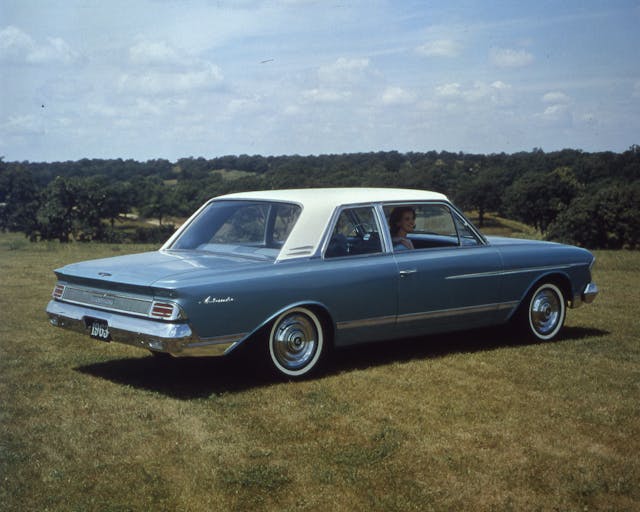
AMC’s full-size car was built in eight generations from 1958 to 1974 and could be had in a wide range of body styles, which often changed yearly, typical of its Big Three competition in that era. A rare sight at car shows, these big cruisers are bursting with style, as the Ambassador often served as the flagship model for AMC. In 1968, Ambassadors came equipped with standard air-conditioning while the feature was still optional across most of the industry, even on much more expensive models.
Our pick: While we love the funky, finned, ’50s four-door hardtop wagons, as well as the stylish two-door hardtops, we’ve got to go with the 1965–66 wagon. The interesting front-end treatment, with stacked headlights and horizontally mirrored grille, makes it look almost like a concept car. It was practically built for a Route 66 road trip. Besides, most of the rest of our picks are gonna be two-doors—we’ve got to be at least a little bit practical.
AMC Rambler American
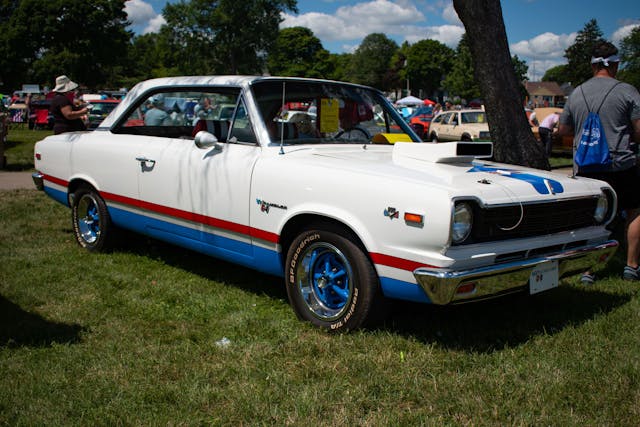
Built over three very different generations, the Rambler began as an elegant, sleek compact that stood out from the larger cars that were then dominating the market; it practically looked like a European import. The third generation introduced V-8 power to make a compact muscle car, the SC/Rambler, that would take on the sportier variants of the Dodge Dart, Ford Falcon, and Chevy Nova.
Our pick: The SC/Rambler with its red, white, and blue paint scheme is an easy choice, but we’ll go with some of AMC’s later models when it comes to patriotic color schemes. For our favorite Rambler, we’re gonna cheat a bit and pick an IKA Torino, which is what you get when Pininfarina gives this AMC a makeover. Built and sold by Industrias Kaiser Argentina and later Renault, the South American models were made famous thanks to their racing prowess. We’ll be honest, we wouldn’t care if they never took a checkered flag; we’re just interested in the looks.
AMC Rambler Marlin
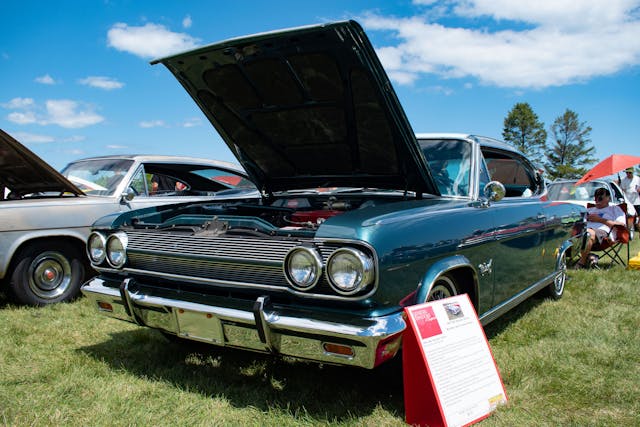
AMC’s midsize Rambler Classic spawned the fastback Rambler Marlin, whose sleek lines inspired Dodge to build the first-generation Charger. After just two years, Marlin moved to the larger Ambassador platform and kept the fastback design.
Our pick: We’re going to select the first-year Marlin, the 1965 model, which essentially serves as our favorite version of the Rambler Classic as well.
AMC Javelin
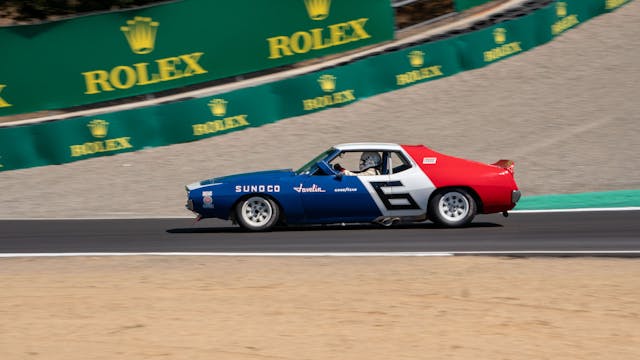
Whether it’s the rather understated early versions or the audacious, flared variants that came later, AMC’s take on the pony car is an attractive package. Like any good pony car, the Javelin was available with options to customize the style and performance, with several potent V-8 available. A blue, white, and red Javelin campaigned by Mark Donohue in 1971 brought the Trans Am championship to AMC for the first time, and in 1972, AMC nabbed driver George Follmer to repeat the performance.
Our pick: The one-year-only 1970 models featured a unique front end that is just different enough to notice from a distance. We’ll go with a 390 V-8 and a four-speed, in the red, white, and blue paint scheme that was the opposite orientation of the SCCA models.
AMC AMX
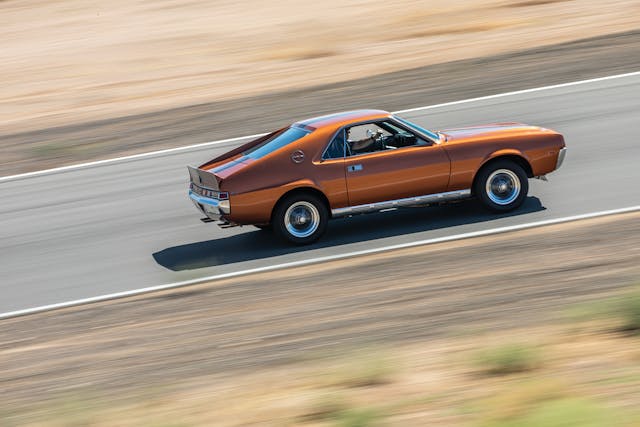
To create a two-door sports car and compete with Chevrolet’s Corvette, AMC shortened the Javelin and restyled it from the doors back. It’s a cost-cutting theme to which the company would return, but the AMX was arguably the best implementation of the strategy. AMC was proud to announce that the AMX started at less than $4000, the price of a loaded Mustang or Camaro. Production lasted from 1968 to 70, at which point “AMX” became an option package for the Javelin, then the Hornet, and eventually the Spirit.
Our pick: The AMX came standard with a V-8 and a four-speed with Hurst shifter, so pick your favorite AMC V-8, pick your favorite color, and go.
AMC Rebel

AMC’s mid-size follow-up, the Rambler Classic, filled a lot of roles as it was built in convertible, sedan, coupe, and wagon body styles. All of them look good, with interesting design cues like fenders and quarter panels with bulges to mimic the lines of their close-fitting bumpers, a design feature shared with the 1967–68 Ambassador.
Our pick: For style, it’s tough to beat the sleek looks of the 1967–69 hardtop, but we’ll still have to go with the 1970 Rebel Machine. It featured a 340-hp 390 V-8 that breathed through a sizable hood scoop and was available with a red, white, and blue paint scheme. It was loud, it was brash, and it was a solid performer thanks to a more powerful V-8 than even the AMX had. What’s not to love?
AMC Hornet

The compact Hornet sedan, successor to the Rambler American, was offered in two- and four-door variants when it debuted in 1970. A year later, it was joined by the Sportabout wagon, which AMC proudly claimed was “America’s only compact station wagon.” A sporty two-door hatchback joined the party in 1973. All of the body styles are rather attractive in their simplicity; perhaps that’s why we think they’ve aged so well. The muscular SC/360 version used a, you guessed it, 360 V-8 engine and was offered in muscle-car-appropriate colors and with a ram air induction system.
Our pick: While the most famous Hornet has to be the red hatchback from The Man With the Golden Gun (1974), the car that completed the miraculous corkscrew jump, we’ll take an earlier SC/360 model. How about a 1971 with the optional four-barrel, 285-hp engine with dual exhaust, four-speed manual, and 3.91:1 rear-axle ratio with Twin-Grip differential?
AMC Gremlin

AMC was used to being an underdog and doing a lot with a little. When it needed a more affordable, smaller car, it took the already compact Hornet, cut out 12 inches of wheelbase, and hacked off the rear to create the Gremlin. Sound familiar? Compared to the wonderfully proportioned AMX-GT concept that spawned the truncated subcompact, the Gremlin is a bit awkward. That doesn’t stop us from loving the odd little hatchback.

Our pick: Our initial thought was this wild, tracked Gremlin we spotted at SEMA in 2022, but how about something a bit more practical—a 1972 Gremlin X in Wild Plum? The 304 V-8 wasn’t a brutal powerhouse at the time, yet it was still punchy in the lightweight Gremlin. A modern tune-up with a decent cam and intake would make it a zippy runabout.
AMC Pacer
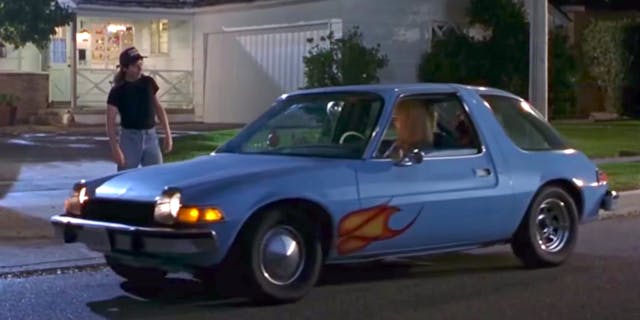
You can’t say that AMC was averse to taking risks. The Pacer offered unique, even strange styling with some practical benefits. The most oft-cited example is, of course, the passenger side door, which was longer than the driver’s to encourage rear-seat passengers to enter and exit on the curb side, where it was safer. The efficiently packaged interior offered fantastic visibility thanks to a greenhouse that used more window area. The car was also designed to be easy to repair.
Our pick: Our favorite Pacer has got to be the Mirthmobile, the only famous Pacer in existence. With a roof-mounted red rope licorice dispenser and a dash-mounted cup dispenser to go along with what appears to be an on-board water supply, it has tremendous road-trip potential.
AMC Eagle

These utilitarian sedans and wagons aren’t particularly eye-catching and would have blended in with plenty of their contemporaries if it weren’t for the fact that they rode a bit taller on their 4×4 suspensions. The drivetrain made them a precursor to the ubiquitous crossover and served to highlight AMC’s ambitious attempts to carve out new segments in the market. The Eagle sedans and wagons were based on the Concorde, the successor to the Hornet.
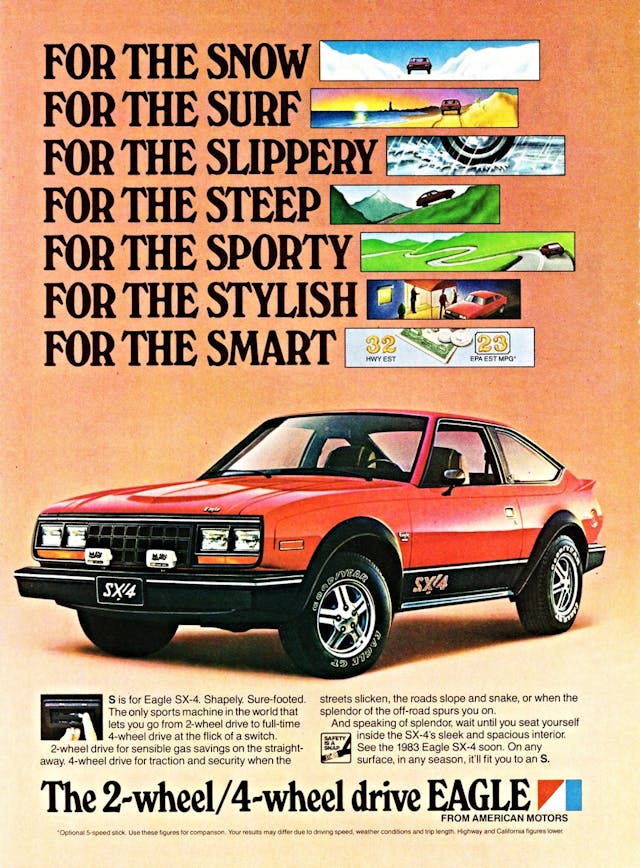
Our pick: The SX/4 three-door that was based on the smaller AMC Spirit is a rare sight today and would make for a fun rallycross-inspired toy.
Bonus:
XJ Jeep Cherokee

The XJ wasn’t branded as an AMC, but AMC was Jeep’s steward from 1970 to 1987 and the Cherokee was AMC’s largest contribution to the brand over that period, as most of the other models available were carryovers from Kaiser.
These boxy wagons weren’t the first compact SUV, although they set the stage for the future in several important ways. With lightweight unibody construction and a solid front axle with coil-spring suspension, the XJ Cherokee was maneuverable and capable off-road and had a decent ride on-road. Its quadra-link suspension made its way to the original Grand Cherokee in 1993 and TJ Wrangler in 1997. The Grand Cherokee was initially planned to replace the Cherokee, although strong sales kept the XJ in production until 2001 in the United States. Reskinned versions were on sale in China until 2014.
Our pick: A 1997–99 4.0-liter model to get the best of the upgrades that started in 1997 but the last of the high-pinion Dana 30 front axles.
This list had to be cut short, but we’ve managed to cover a pretty big swath of AMC’s lineup. Our favorites were biased toward the ’60s and ’70s, so let us know if we’ve overlooked your number-one AMC.
***
Check out the Hagerty Media homepage so you don’t miss a single story, or better yet, bookmark it. To get our best stories delivered right to your inbox, subscribe to our newsletters.
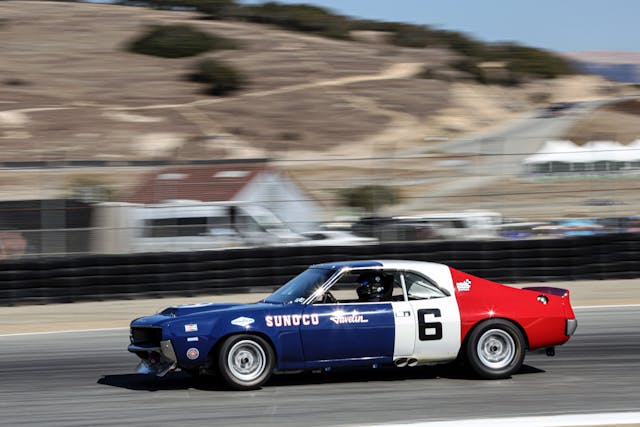
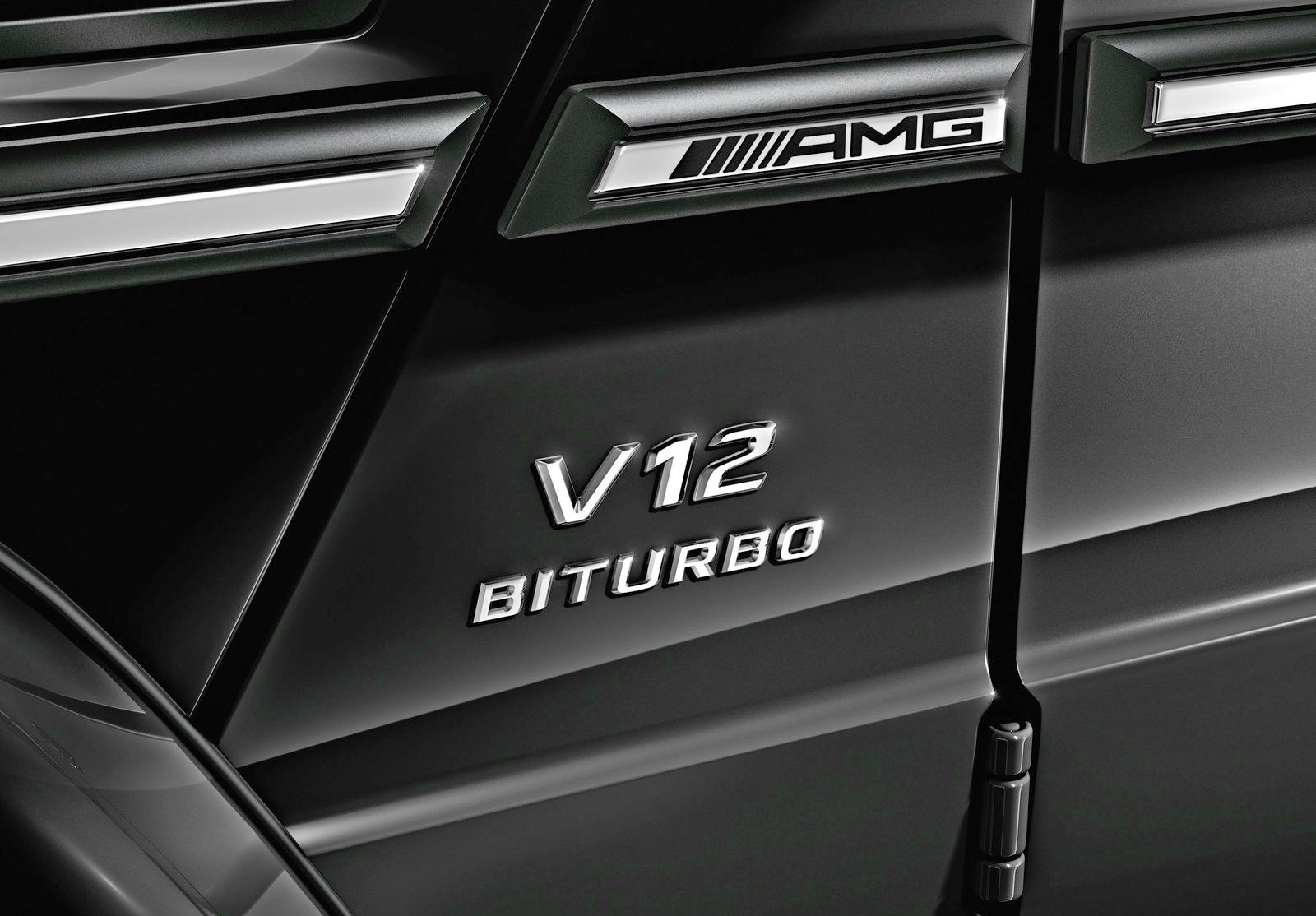

Don’t know why AMC never put the 401 in the Javalin or AMX. Great motor.
Actually in 1971 the 401 was available in the AMX which now shared the same body as the Javelin. My best freind in high school had a Silver 1971 AMX with the 401, it looked fantastic!
The 401 was not available until the latter part of the 1970 original AMX run, its final year as a stand alone 2-seater. It was the 390 with the benefit of a bore and stroke upgrade as was the 343 to 360 and the 290 to 304 in the AMC-built V8 engines. The Javelin AMX option for 1971-74 could come with a 401 CID V8, always matched with 4 barrel carbs.
The 401 engine was not available in “the 1970 original AMX run”.
The 401 engine was not available in “the latter part of the 1970 original AMX run”
It would be helpful for those who don’t remember or weren’t around then to have photos of the cars that were selected. ie: ’65 wagon. We had a ’65 4 door Classic with HD suspension straight 6. Beat the crap out of my friends ’66 Ford Galaxie with 289 on the back roads but left me in the dust on the straights. Both were the family cars.
I had an Hornet Sportabout with the V8 engine, great wagon for zipping around the mountain roads where I live.
I would trade my 1995 LT-1, 6-speed Corvette for a 1970 AMX V8. Probably have to “pony” up some cash also. I will have to find some place to check AMX values.
The cop car black and whites on “Adam 12”
They looked to go and handle better than the others, Belvederes or whatever they were called back then. Mid size Plymouths. Or Coronets.
I like seeing them, but you were wise to leave off the Matador.
Owning 2 AMC vehicles now and owning a number more in the past…..I am bias. My 73 Javelin is a GREAT car. I was asked to show it as the International SAE conference a few years ago as part of American cars display. I was surprised by how many engineers and designers were looking over my Javelin. A interior designer told me, after looking inside for a while, ‘This car IS the 1970’s style in a single car’. Good or bad I took ot as a compliment, I also have a 74 Matador coupe……
Boo-hoo. You did not include the magnificent 1962 Rambler American Custom four door. I have a lovely 40 000 mile example built in Brampton Ontario at the then new AMC plant. Flat six, seats recline to a bed, other quirks.
Great article! Only AMC I ever owned (briefly) was a big Ambassador wagon used for hauling tech and registration supplies to Blackhawk Farms. I dubbed it the USS Charles N. Nash. I lusted after a few others, notably the AMX and the Eagle Wagon. When I say a have an Eagle tsi, many people say “That’s that 4WD Rambler wagon, isn’t it?” You mentioned all the glass on the Pacer. Whenever I saw one, I went to look in to see if there was a big white ball floating in there with N-E-S-W printed on it at 90 degree intervals.
I always thought of AMC as a collection of wannabes. I followed the TransAm races very closely. went to Bryer motorsport Park and Lime Rock every year. I actually felt betrayed when Mark Donohue left Chevy and went to AMC, however, that betrayal turned to respect when Team Penske started winning races. Opened my eyes to the possibility that the driver and team are more important than the car. I had a friend who was a mechanic at an AMC dealership. He showed up one evening with an AMX/390. We took it to a large parking lot and had our way with her. It scared me. It was way to much car for this kid that drove a 74HP foreign sports car. Never did develop any interest in American Muscle, although I loved the styling.
How could you not love the Studebaker WAGONAIRE ? with the rear half of the roof sliding forward into the front half so that you could do things like my neighbour who hauled a honda trike in the back with the handlebars sticking up well above the roof line . His Dad had a real Studebaker Avanti at the same time.
Well I DO love it. But Studebaker and AMC were not the same company. There was a dream, but the sudden death of one of the principal execs kept the “Big Four” from coming to fruition. It’s quite a story.
Sorry, but your first picture captioned Ambassador is definitely not one of those. It is without a doubt a 63-64 Classic.
The state of Alabama had a fleet of Javelin State Trooper cars in the 70’s. Rumor has it they were always delivered to Talladega Superspeedway, where they were unloaded and driven around the track. Any that wouldn’t run at least 160 MPH were loaded back on the transport carrier and sent back. Supposedly, not many had to be returned.
During my vehicle history I owned two AMC products, both of which we kept for an extended period of time and which gave good service.
The first was a 1970 Ambassador SST two door hardtop with a 390 engine, a Borg Warner automative transmission. yellow with a black vinyl roof, and black vinyl interior, bought new. Motor Wheel custom wheels were added for a different look and the headlamps were swapped out for significantly improved units. It was used to tow our Apache hard side pop up camping trailer for many summers. If driven briskly, the brakes were inadequate for the power of the engine, which was probably typical of large engined American cars of the era. I always liked the simple design of the car.
The second was a 1984 Concord station wagon, 6 cylinder, 5 speed, metallic blue with no fake wood on the sides and no roof rack. The power was just adequate and the handling was decent for what it was. Improvements included replacement European pattern headlamps and under bumper fog lamps.
Even though we lived in the snow belt, and both were rear drive only, both were OK in the winter when equipped with dedicated winter tires.
I do not regret either purchase.
I love my 1966 Rambler 770 Classic convertible, 287 V8. Cruise it to car shows all summer long and have never seen another one ever at any of those shows.